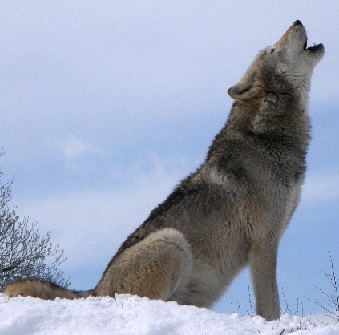The Domestication of Dogs
 Thanks to scientific research, we have known for quite some time that domesticated dogs, the furry friends we love like family, descended from wolves and more specifically from grey wolves. However, in recent years researchers have been in conflict as to how, when and where this evolution came about. The conflict boils down to the fact that for many of the questions concerning the domestication of dogs the simple and truthful answer is "We don't know."
Thanks to scientific research, we have known for quite some time that domesticated dogs, the furry friends we love like family, descended from wolves and more specifically from grey wolves. However, in recent years researchers have been in conflict as to how, when and where this evolution came about. The conflict boils down to the fact that for many of the questions concerning the domestication of dogs the simple and truthful answer is "We don't know."
Searching for When, Where and How?
We do know that wolves have been here for 750,000 years to more likely close to two million years and we also know of at least 32 living subspecies. We also know that after domestication took place dogs continued to breed with wolves from time to time throughout their history, making the DNA in the dog genome even more interesting and difficult to trace backward in time. For example, in 2015, one study estimated that as much as 25 percent of modern DNA sampled from Eurasian wolves comes from domesticated dogs, a result of interbreeding.
A couple of years ago, questions about when domestication of dogs took place received answers that stated approximately 10,000 years ago to 30,000 years ago as the answer. Then the results of a study released in 2017 said no, it's 40,000 years ago. Thus, the answer to when domestication of dogs took place all depends on which scientist you ask.
Where on the planet dogs were domesticated from grey wolves is another question we simply don't know the answer to. Some scientists argue for East Asia, some for Central Asia, some for Europe and some for the Middle East. Once again, it depends on whom you ask.
How the process of domestications took place is another mystery and different scientists propose different theories as to "how." Dogs are the only large carnivore humans have domesticated. However, I read one study where a scientist suggested wolves domesticated themselves and became our "dogs" for their own benefit -- interesting, and possibly true.
When we think about ancient wolves, they were actually our competitors when it came to food. So, why not collaborate with humans in the work, helping with the hunt, then lie around the campfire and eat the rewards from the day of hunting. I've always said many animals are smarter than humans and dogs certainly rank higher up on my opinionated list than we Homo sapiens when it comes to intelligence. Dogs live in the present each moment, something it seems increasingly difficult for humans to do in our "modern" world.
However, whenever and wherever it came about, the domestication of dogs is an interesting story. Reading the opposing viewpoints, especially those expressed in two recent studies, one published in 2016 and one in 2017, provided ample evidence that regardless of the facts, dogs have been with us for a long long time.
Results of a study published in 2016 in the journal Science hypothesized that dogs were domesticated twice in independent processes in different parts of the world. In 2017, scientists argued against the prior study, saying, "No, that's not how it happened. Dogs were domesticated from grey wolves only once." But then ask when and where this happened and you'll receive multiple answers from both sides.
Larson's Study
The research published in 2016 was conducted by a group of scientists led by archaeologist, geneticist and evolutionary biologist Greger Larson of the University of Oxford. This 2016 publication stated that domestication MUST have taken place twice in independent processes in different parts of the world because of the obvious divergence in the DNA of ancient Asian dogs when compared with that of ancient European dogs. However, Larson's group of researchers thinks these European lines are the ancestors of the majority of modern-day dogs.
As part of the study, Larson and his team analyzed the DNA from a fossilized dog bone found near Newgrange in Ireland. When comparing the DNA sequences of approximately 700 modern dogs with that of the Newgrange specimen, the researchers concluded that an obvious split in the DNA tree could only be explained by dogs having been domesticated twice in different parts of the world.
Looking at the DNA of modern dogs and comparing this with that of fossil specimens from thousands of years ago seems to only add to the mystery. Speaking about the results to The Atlantic Larson said, "The patterns we see could have been created by 17 different narrative scenarios, and we have no way of discriminating between them."
Veermah's Study
Then in 2017, a different group of researchers said, "Wait a minute. That's not how it happened." Results from a study published in Nature Communications, dated July 18, 2017, argued for domestication of dogs from grey wolves only once and stated that the process could have taken place approximately 40,000 years ago.
Krishna Veeramah, a palaeogeneticist who works at Stony Brook University in New York, wrote in the 2017 study that scientists continue to come up with different answers about when and where domestication of dogs took place. Veeramah and his group compared ancient canine genomes with those of modern dogs and concluded that domestication took place once around 37,000 to 41,000 years ago; subsequently, the split into eastern and western dogs took place around 20,000 years ago, according to Veermah's group. This obvious split, they think, is why other scientists argue for domestication taking place twice.
The opposition, so to speak, to the 2016 study, says the divergence in the two groups of dogs - one from East Asia and one from Europe - did indeed happen but that the two groups have the same ancestors. Then the European line also spread across Africa as well as throughout South and Central Asia.
Larson disagrees. After Veermah's study was published, Larson said it does not explain the huge difference between dogs descended from ancient Asian dogs and those with ancient European ancestry.
Then Veeramah was quoted in Nature magazine as saying that the disagreement results from archaeologists going with one theory and geneticists and Veeramah remains an advocate of domestication taking place only once. He believes this process started when less aggressive wolves began coming physically closer to humans, likely eating scraps from human meals. Over time these nonthreatening animals became human companions and eventually hunted in tandem with human hunters.
Looking Forward
 One thing scientists do tend to agree on is that to know more for certain, additional samples of ancient canine DNA are needed. Thankfully, scientists around the world are collaborating in their efforts to find more samples and that will help reveal the truth.
One thing scientists do tend to agree on is that to know more for certain, additional samples of ancient canine DNA are needed. Thankfully, scientists around the world are collaborating in their efforts to find more samples and that will help reveal the truth.
Think about this: compare a French bulldog to a Saint Bernard, compare a Chihuahua to a Great Dane, compare a Chow Chow to a Beagle and so forth. The obvious difference, obvious to the eyes anyway, is that humans have deliberately bred dogs for specific traits for centuries. As more DNA samples become available the results should become more accurate in pinpointing just where and when domestication took place. However, regardless of how well scientists can determine the where and when, the "how" will be left to our imagination.
Larson was quoted in The Atlantic as saying, domesticated dogs "altered our relationship with the natural world." This mutually beneficial relationship is something we take for granted now. Yet, I'm curious to see what the next study concludes. Whatever it may turn up, it's obvious that dogs have been and will remain our companions for many many many years.
References:
- Discover Magazine: The Origins of Dogs; December 2016
- Nature: Ancient Genomes Heat Up Dog Domestication Debate
- Phys.org: Study Throws Dog Domestication Theories to the Wolves; July 18, 2017
- Science Magazine: Dogs May Have Been Domesticated More Than Once; June 2, 2016
- Smithsonian Magazine: New Study Has a Bone to Pick With Dog Domestication Findings; July 19, 2017
- The Atlantic: A New Origin Story for Dogs; June 2016
